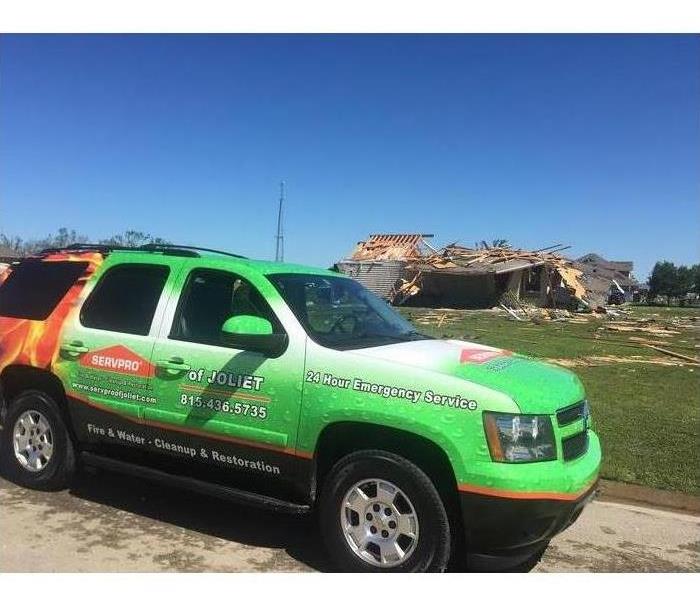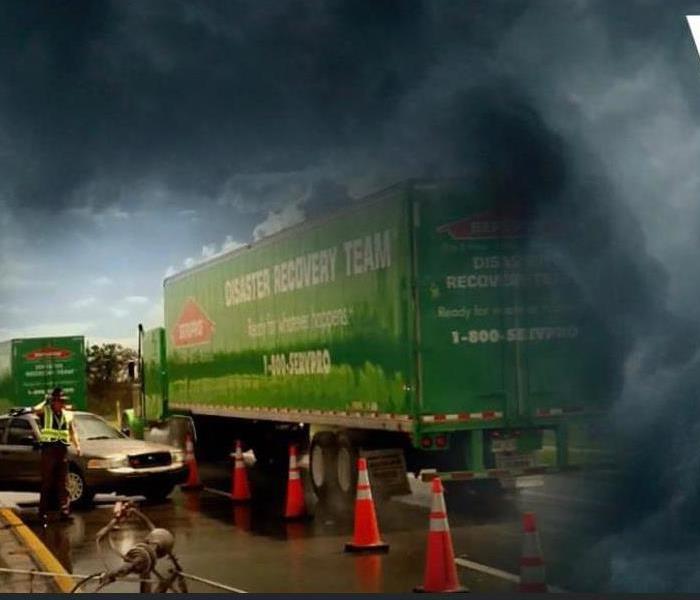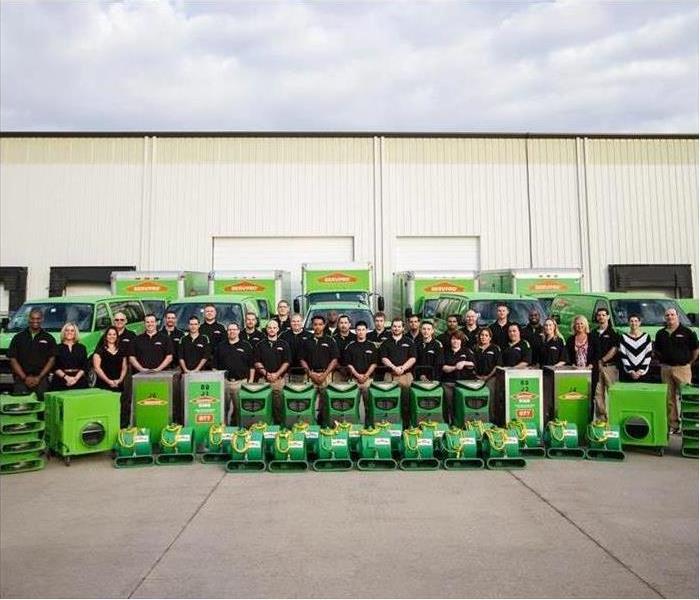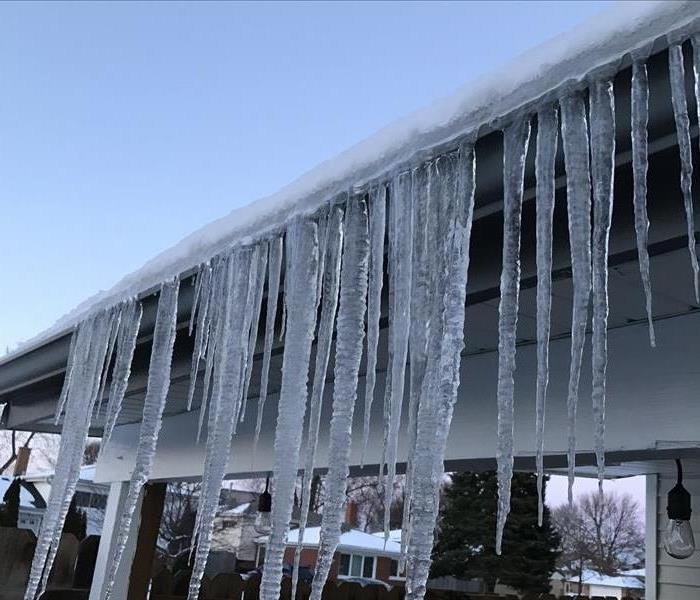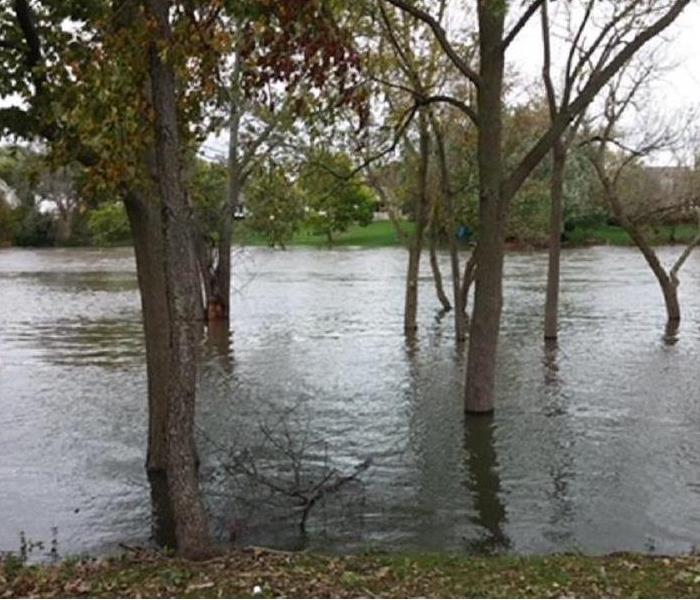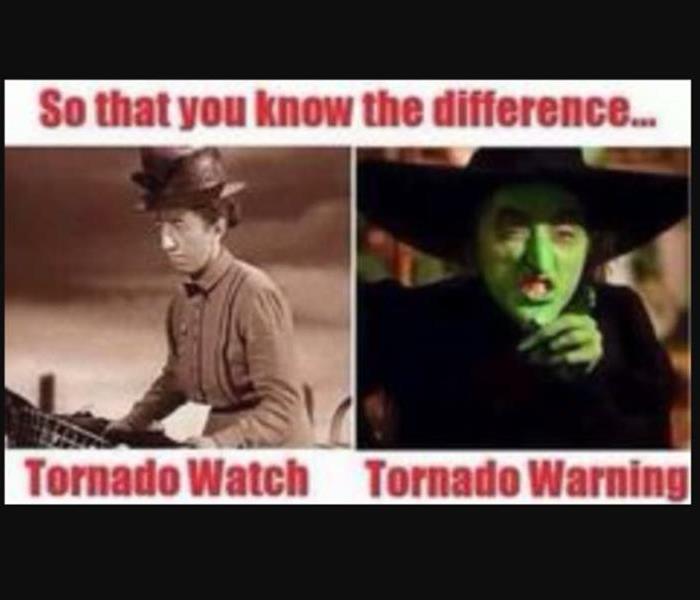Archived Storm Damage Blog Posts
Storm Damage? Call SERVPRO
7/17/2024 (Permalink)
Storms can be unpredictable and take a toll on your home or commercial space, which can cause damage to both the interior and exterior of your property. SERVPRO of Joliet understands that these disasters can come at any time and provides emergency services 24 hours a day, 7 days a week. We have trained, on-call professionals to respond to your loss, and our teams make it a priority to be faster to any size disaster. This immediate response time can lessen damage, cleaning time and costs as further damage will be prevented. So, if your property is ever impacted by storm damage, do not hesitate to call SERVPRO of Joliet at any time, day or night. We are always Here to help.
For residential services that can bring you peace of mind when something goes wrong, SERVPRO of Joliet offers water damage restoration, fire damage restoration, mold remediation, storm damage restoration, general cleaning and building services. A commercial property impacted by damage can also be restored by SERVPRO with services such as commercial water damage restoration, commercial fire damage restoration, commercial mold remediation, storm damage and large loss event restoration, and cleaning services.
Preparing For A Storm
8/1/2023 (Permalink)
Floods are the most common natural disaster in the United States.
- Know types of flood risks in your area. Visit FEMA's Flood Map Service Center https://msc.fema.gov/portal for information.
- Sign up for your community's warning system (EAS) The Emergency Alert System.
- If flash flooding is a risk in your location, monitor potential sign, such a heavy rain.
- Learn and practice evacuation routes, shelter plans,and flash flood response.
- Gather supplies in case you have to leave immediately or if services are cut off including medications, pet needs, batteries or and other critical equipment.
- Purchase or renew a flood insurance policy. It typically takes up to 30 days to go into effect. Get Flood coverage under the(NFIP) the National Flood Insurance Program.
- Keep important documents in a waterproof container. Create password protected digital copies.
- Protect your property by moving valuables to higher levels, declutter drains and gutters, install check valves and consider a sump pump with a battery.
Remember that SERVPRO of Joliet, 815-436-5735 is available 24/7 to help you if the need should arise.
After the storm
7/15/2023 (Permalink)
This Spring and Summer has been quite a wet and stormy one and with that comes weather related injuries and fatalities. This is why it is important to educate both you and your family about post-storm safety.
Immediately after a storm where there was heavy rain, strong damaging winds, and lightening consider the following:
- Do not let children play near storm drains. Every year children are sucked into storm drains and carried away.
- Do not touch metal objects outside, there may be power lines down on the object which energizes the object. This could be a fence, guard rail, or baseball stop.
- Do not touch or pick up any wires that you see either laying on the ground or hanging low. They may be energized or could become energized at any time.
- Do not walk in flooded basements if your power is still connected. You could become electrocuted should water make contact with an electrical source.
- If your home is out of electrical power, use extra caution when using candles for light.
- Be careful using a gas powered generator which could cause Carbon Monoxide poisoning if not vented properly.
Please remember to keep you and your family safe and remember that SERVPRO of Joliet, Illinois is always available to help you with your restoration needs. 815-436-5735.
Storm Season
6/29/2023 (Permalink)
Tornadoes are violent and can completely destroy well-made structures, uproot trees and send objects through the air like deadly missiles and they can happen anywhere. Here are some tips to keep you and your loved ones safe.
- Identify a save place in your home where family and pets will gather during a tornado: a basement, storm cellar or an interior room on the lowest floor with no windows.
- In a high rise building, if you don't have have enough time to go to the lowest floor, pick a hallway in the center of the building.
- In a mobile home, choose a safe place in a nearby sturdy building. If your mobile home park has a designated shelter, make it your safe place. No mobile home is safe in a tornado.
KNOW THE DIFFERENCE!!!!
Tornado Watch: means a tornado is possible.
Tornado Warning: means a tornado is already occurring or will occur soon. GO TO YOUR SAFE PLACE IMMEDIATELY.
Always remember to play it safe and we are always here, if you need us. SERVPRO of Joliet 815-436-5735.
Storm Damage Tips
3/15/2023 (Permalink)
Storms can occur with little warning in Illinois and have devastating effects on your home or business. If your property has been damaged by a sudden storm, follow these helpful tips to minimize damage and keep your family safe:
What To Do After Flooding
- Remove excess water by mopping and blotting.
- Wipe excess water from wood furniture after removal of lamps and tabletop items.
- Remove and prop wet upholstery and cushions.
- Place aluminum foil or wood blocks between furniture legs and wet carpeting.
- Turn air conditioning on for maximum drying in summer.
- Remove colored rugs from wet carpeting.
- Remove art objects to a safe, dry place.
- Gather loose items from floors.
What NOT To Do After Flooding
- Don't leave wet fabrics in place. Hang furs and leather goods.
- Don't leave books, magazines or other colored items on wet carpet or floors.
- Don't use your household vacuum to remove water.
- Don't use television or other household appliances.
- Don't turn on ceiling fixtures if ceiling is wet, and keep out of rooms where ceilings are sagging.
Call the restoration specialists at SERVPRO of Joliet if you have experienced storm damage. We will respond quickly and begin the process of expertly restoring your property. We are available 24 hours a day, 7 days a week at 815-436-5735.
Storm Damage to Your Educational Facility
2/21/2023 (Permalink)
AT SERVPRO of Joliet we believe learning shouldn’t be paused or canceled, even in the face of disaster. Disasters at an educational facility are highly complex and require a knowledgeable and flexible response. Whether we’re dealing with a small school or a campus of higher education, we work quickly to assess each unique situation and isolate the damaged area so that normal operations can continue while we restore your facility.
Our professionals are trained to be mindful of legal and environmental concerns and strive to fully restore the damaged area. Your job is to provide valuable lessons and information to the students; ours is to make sure you have a safe place to do so.
Our experience in handling educational facilities cleanups has given us the ability to provide a variety of detailed services for the following educational facilities:
- K-12 Schools
- Colleges & Universities
- Dormitories
- Event and Sporting Arenas
- Libraries
- Daycares / Pre-K Facilities
Addressing Ceiling Leaks After Storm Damage
1/21/2023 (Permalink)
Severe weather may bring on high winds and heavy rain – leading to a leaking roof from storms. All Joliet property owners must know what to do should water damage form due to a recent storm. The sooner you enlist the help of trained SERVPRO technicians to handle water damage remediation, the easier the clean-up and repair will be!
Storm damage in Joliet can happen at any time, but SERVPRO is the team to call when you require ceiling repairs from water damages. There are a few telltale signs to help determine whether you have water damage from a storm, including:
- Excessive dripping
- Stains on your interior walls or ceilings
- Damp or soft spots on your roof
- Materials that begin to sag
- Notable signs of structural collapse
Should you have ceiling leaks and roof damage, SERVPRO offers emergency board-up and tarping services to keep your interior from suffering excess loss. We will also handle all debris removal, water extraction, and drying required during the restoration process.
You must know what to do and who you can call once you suffer from storm damage that impacts your home. SERVPRO of Joliet has a Green Fleet filled with equipment, and we can dispatch a crew to your home within hours of your call. Reach us 24/7!
Power Outage
12/14/2022 (Permalink)
Surprisingly, power outages are even getting worse in the USA. The annual average of powevery five years! The reason for this has to do with aging infrastructure, more frequent storms, and problems sustaining the electric grid as populations grow.
Despite how common power outages are, few people are prepared for them and even fewer people know what to do if the power goes out.
Steps to Take Immediately After the Power Goes Out
Step 1: Turn On Your Emergency Lights
Make sure your emergency lights are somewhere accessible in case you have to find them in the dark. Ideally, keep a flashlight in each room of your Joliet home.
In general, it is better to use battery-operated lights instead of candles because of the fire risk.
Step 2: See If Your Neighbors Have Power
If your neighbors still have electricity, then the problem is likely inside your home. Start by checking the main fuses or circuit breakers to see if they have blown.
Step 3: Check the Extent of the Problem
If your neighbors also don’t have electricity, you’ll want to see how wide-spread the problem is. You can do this by calling your power supplier. It might take a while to get through to them if a lot of people are trying to call.
You can also try calling friends who live nearby to see if they have power or not.
Step 4: Contact Family Members
During large power outages, stoplights and streetlights can go out too – making it unsafe to drive.
If your family members aren’t at home, get in contact with them. It might be best for them to remain at their current location until it is safer for them to come home.
Note that your family should have a contact plan in place.
Step 5: Unplug Appliances
When the power comes back on, it can cause a huge power spike which may damage electronics.
Hopefully all of your sensitive electronics are on surge protectors.
Even if they are, it is still smart to unplug all of your sensitive (expensive) electronics from the wall so they don’t get damaged when the power comes back on.
Step 6: See if Water is Safe to Drink
When the power goes out, water treatment centers might not work. You could still have clean-looking water coming from the tap, but it might not be safe to drink!
Call your local authorities to see if the water is safe to drink. Or, you can listen to your emergency radio to see if there is a “boil alert” in place.
**If you are unsure whether the water is safe to drink, always play it safe! Treat water before drinking it or use bottled water.
Protecting your home against flooding
11/30/2022 (Permalink)
Flash Flood Warning-- the alert that many of us dread because of the concerns that our homes will be affected by it. SERVPRO of Joliet understands that your home is more than a structure: it's your family’s furniture, clothing, keepsakes, and other belongings that help transform a house into a home. Here are some helpful suggestions on how to protect your property just in case disaster happens.
How to Protect Your Property:
- Keep insurance policies, documents, and other valuables in a safe-deposit box. Keep them in a place where it's least likely to be damaged by a flood.
- Raise your furnace, water heater, and electric panel to higher floors if there are areas in your home that are capable of being flooded.
- Install check valves in building sewer traps top prevent flood water from backing up into drains of your home.
- Seal walls in basements with waterproofing elements to avoid leakage through cracks.
Severe Thunderstorm Warning for Joliet
8/7/2022 (Permalink)
Thunderstorms are common in the summer months. Our local team in Joliet responds to storm damage emergencies every year and offers these thunderstorm safety tips from the American Red Cross:
Severe Thunderstorm Watch - Severe thunderstorms are possible in and near the watch area. Stay informed and be ready to act if a severe thunderstorm warning is issued.
Severe Thunderstorm Warning - Severe weather has been reported by spotters or indicated by radar. Warnings indicate imminent danger to life and property.
- Learn about your local community’s emergency warning system for severe thunderstorms
- Discuss thunderstorm safety and lightning safety with everyone in the building
- Pick a safe place in for people to gather during a thunderstorm. This should be away from windows, skylights, and glass doors that could be broken by strong winds or hail.
- Make a list of items to bring inside in the event of a severe thunderstorm
- Make trees and shrubbery more wind resistant by keeping them trimmed and removing damaged branches
- Consult your local fire department if you are considering installing lightning rods
- Get trained in first aid and learn how to respond to emergencies
Stormy Weather
7/6/2022 (Permalink)
June 22, 2015 is a date that the residents of Coal City, Illinois will never forget. An EF-3 tornado, with winds estimated at 160 miler per hour ripped through the town causing wide spread devastation to the community. SERVPRO of Joliet was called in to assist with the damages. We were given the opportunity to help families try to get their lives back to some kind of order considering what they had just been through. When a disaster hits, it is not always about the property damage but also about being compassionate and caring of each individual affected by it.
"During a difficult time, SERVPRO was respectful, helpful, professional, and made a horrible situation better." - Kristin C.
"At a difficult time in our lives, SERVPRO was caring, supportive, and attentive, thank you!" - Lance C.
It is comments like these that make us proud to be the company we are today: from taking care of all their personal belongings and content, to cleaning and rebuilding the damage done to their homes and properties.
Our highly trained professionals are available 24/7, 365 days a year, to handle any disaster from beginning to end and make it "Like it never even happened." If ever the need arises, call 815-436-5735.
Tornado Season!!
6/25/2022 (Permalink)
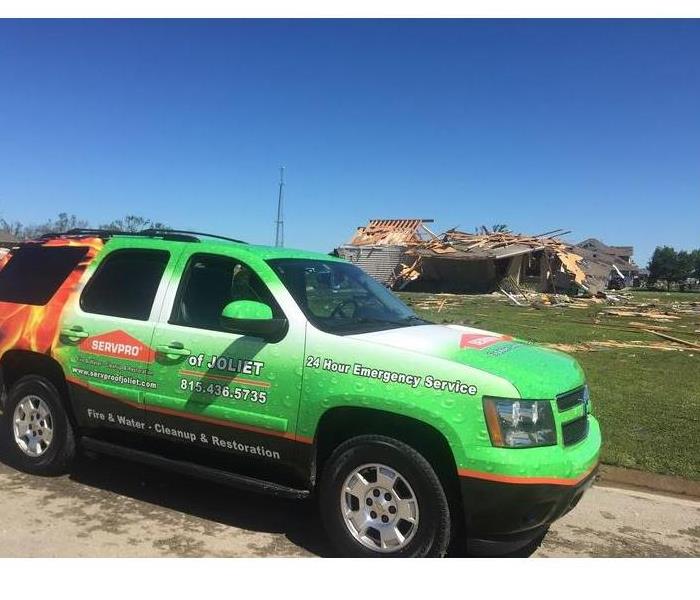 Coal City Tornadoes from 2015
Coal City Tornadoes from 2015
Tornadoes are violent and can completely destroy well-made structures, uproot trees and send objects through the air like deadly missiles and they can happen anywhere. Here are some tips to keep you and your loved ones safe.
- Identify a save place in your home where family and pets will gather during a tornado: a basement, storm cellar or an interior room on the lowest floor with no windows.
- In a high rise building, if you don't have have enough time to go to the lowest floor, pick a hallway in the center of the building.
- In a mobile home, choose a safe place in a nearby sturdy building. If your mobile home park has a designated shelter, make it your safe place. No mobile home is safe in a tornado.
KNOW THE DIFFERENCE!!!!
Tornado Watch: means a tornado is possible.
Tornado Warning: means a tornado is already occurring or will occur soon. GO TO YOUR SAFE PLACE IMMEDIATELY.
Always remember to play it safe and we are always here, if you need us. SERVPRO of Joliet 815-436-5735.
A Coordinated Response For A Large Disaster
6/22/2022 (Permalink)
Not all disasters are created equal, and a catastrophic loss requires a large response. With a local presence in nearly 1700 communities, SERVPRO also has the ability to respond to large disasters. The disaster mitigation franchise has played a helpful role in many of the past decade's biggest storms, from Hurricane Katrina in New Orleans to the great floods in Houston and Texas. That's because the local franchise has access to corporate resources that can be deployed if necessary. It's the best of both worlds: rapid emergency response with arrival in four hours, and added expertise and equipment for large jobs.
Big problems such as flooding, tornadoes and rampant wildfires require knowledge and training. Each disaster has its unique set of problems to address and solve. That's what a successful recovery process calls for. A top remediation team offers the following solutions:
- Trained technicians
- Specialized equipment to address storm damage
- A restoration process that limits expenses
- Quick recovery
- Knowledge to complete difficult tasks
A catastrophic loss in Romeoville, IL, has many aspects, from document damage to the prospect of computer systems being affected. Everything from water removal to soot and smoke damage may need to be addressed. Experience and training combine to meet these challenges.
The Advantages of Organization
Through it all, insurance adjusters and business owners can feel confident that detailed records are being kept to handle an insurance claim. This includes detailed estimates of loss, followed by an itemized list of damaged contents. Photo records of damages will be digitized and all paperwork will be available in hard copy. This information can be sent to all parties so a claim will be processed quickly.
It's important for business owners to know that a company is Here to Help during a catastrophic loss. Corporate resources mean no job is too big, and that recovery is right around the corner.
Driving In A Storm
6/9/2022 (Permalink)
Since we are entering into spring showers and severe storm weather season, here is a refresher on driving in the rain!
Did you know nearly half (47%) of all weather-related car accidents — more than 700,000 a year — are due to rain? Read below for our tips on how to drive safely in the rain.
Here are 10 tips for driving in the rain:
Step 1. Exercise caution. Engine oil and grease build-up on roads and highways over time, and when combined with precipitation, you’ve got the equivalent of an automotive Slip ‘N Slide.
Step 2. Slow down. Wet pavement causes tires to lose traction and vehicles become more difficult to handle.
Step 3. Use headlights. Always use headlights in the rain – even if it’s just a sprinkle. Headlights help you see and be seen in wet weather.
Step 4. Keep your windshield wipers in tip-top shape. Summer can wreak havoc on your blades, so get them checked before fall’s showers arrive.
Step 5. Defog your windows. Precipitation can cause your windshield to quickly fog up, so use the front and rear defrosters to maximize visibility.
Step 6. Avoid pooling water. By splashing through puddles you can impair your vision and other drivers’. Additionally, standing water often shields potholes and debris from view and it can reduce the effectiveness of your vehicle’s brakes.
Step 7. If your car begins to hydroplane, do not brake or turn the wheel abruptly as this may cause your vehicle to go into a skid or spin. Take your foot off the gas and keep the wheel straight until your car reclaims traction.
Step 8. Increase your following distance. Slick roads, wet brakes and reduced visibility can lead to collisions. Give other vehicles plenty of room and brake early with reduced force.
Step 9. Don’t use cruise control. It can cause your car to accelerate when hydroplaning and reduces driver attentiveness.
Step 10. Drive in the tracks of the car in front of you. This allows the vehicle ahead to displace any standing water that’s on the road.
By employing these safe driving techniques you can keep yourself and your passengers safe during spring drizzles and downpours. Rainy roads can be dangerous, but if we all slow down and use extra caution, rainy days might actually be a little brighter.
Prevent Wind Damage From Spring Storms
5/30/2022 (Permalink)
Booming thunder and howling winds that rattle your home are characteristics of severe storms, which are becoming more prevalent as we turn the corner into spring. Strong wind, in particular, can cause damage to homes by breaking shingles and sending tree branches flying. Wind strength varies from storm to storm, ranging from calm wind with speeds below 1 mph to hurricane-force when the strength exceeds 73 mph. FEMA states that doors, roofs, windows, and garages are the most vulnerable areas of the home. If any of these four areas become damaged during a storm, the structure of your home may also be negatively impacted, which may require major repairs. To make sure that your home is protected from wind damage before a severe storm even appears in the forecast this spring, consider the following three tips:
Maintain Landscape and Trees
Strong winds can wreak havoc on the area surrounding your home, resulting in fallen trees and broken tree branches, which can prove to be dangerous to your home if the trees are located close to your home. Be sure not to over-water trees because doing so can weaken the root systems of trees, decreasing their ability to withstand the overwhelming force of strong winds. Finally, be mindful of outdoor objects and equipment, such as outdoor furniture, grills, or sports equipment, as these objects can be moved or manipulated by strong winds, which can risk damage to your home. During storms with strong wind, keep such items either stored in a safe structure, such as a shed, or anchored to the ground if they must remain outside.
Inspect the Roof
Damage to our roofs often goes unnoticed unless it creates a major problem because we cannot see it Therefore, it is important for roofs to be surveyed at least twice per year, during the summer and winter, in order to identify any damage and make sure that it is repaired. When surveying the roof, be on the lookout for loose or missing shingles and water damage in the attic. Hiring a roofing professional may be beneficial in this sense, as he or she may be able to spot hidden damage due to their experience, which could save your roof from devastation in the event of a storm occurring with strong wind. When it comes time to replace your roof shingles, consider choosing weather-resistant shingles that would be able to further protect your roof from wind damage.
Reinforce Windows and Doors
During storms with strong wind, different types of debris, such as tree branches or other outdoor objects, can pound against your home’s windows and doors. In combination with the power of strong wind gusts, these objects can inflict serious damage on vulnerable areas of your home, including doors and windows. To limit the extent of the damage to these areas, install storm shutters as a protective barrier between debris and the window or door. Storm shutters can either be purchased or makeshift storm shutters can be created with plywood. Garage doors are also a vulnerable area of the home during strong wind, so it may also be beneficial to purchase a garage door bracing kit in order to protect your garage door during severe wind and weather.
After The Storm
5/15/2022 (Permalink)
This Spring and Summer has been quite a wet and stormy one and with that comes weather related injuries and fatalities. This is why it is important to educate both you and your family about post-storm safety.
Immediately after a storm where there was heavy rain, strong damaging winds, and lightening consider the following:
- Do not let children play near storm drains. Every year children are sucked into storm drains and carried away.
- Do not touch metal objects outside, there may be power lines down on the object which energizes the object. This could be a fence, guard rail, or baseball stop.
- Do not touch or pick up any wires that you see either laying on the ground or hanging low. They may be energized or could become energized at any time.
- Do not walk in flooded basements if your power is still connected. You could become electrocuted should water make contact with an electrical source.
- If your home is out of electrical power, use extra caution when using candles for light.
- Be careful using a gas powered generator which could cause Carbon Monoxide poisoning if not vented properly.
Please remember to keep you and your family safe and remember that SERVPRO of Joliet is always available to help you with your restoration needs. 815-436-5735.
Storm Damage Tips
5/12/2022 (Permalink)
Storm Damage Tips
- Listen to the radio for advisories
- Do not venture outside until it’s declared safe
- Stay away from downed power lines, standing water, and metal objects near downed wires
- Watch out for snakes and wild animals
- If you smell gas, turn gas off at the meter
- Avoid using candles or open flames indoors
- Operate generators outside
- Be careful when entering or leaving buildings with structural damage. It is best to avoid entering until the damage has been assessed
- Once things have been properly assessed, make sure you have plenty of pictures of storm damage to your property
- Contact SERVPRO of Joliet to come out for board up and get started on water mitigation.
- SERVPRO of Joliet will work with you and your insurance to get your property back to preloss condition
SERVPRO of Joliet 815-436-5735
Tornado Season
4/28/2022 (Permalink)
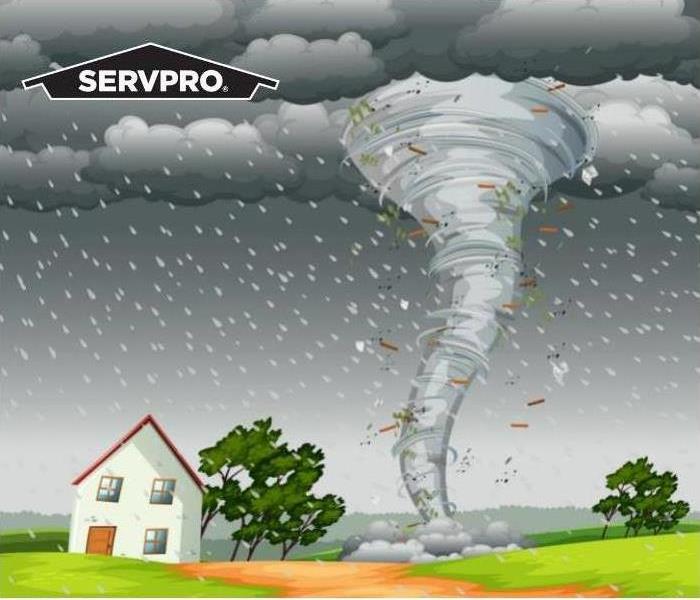 Call the experts at 815-436-5735.
Call the experts at 815-436-5735.
Here we are, folks! Once again, we have reached Tornado Season. Spring and early summer attract tornadoes due to the temperature constantly fluctuating between hot and cold. Tornado season peaks in the Southwest region during April and May while the Midwest region peaks during June and July. The US, however, records the highest number of tornadoes occurring during May, with a whopping average of 1,200 tornadoes per year.
Meteorologists and weather services can sometimes provide advanced notifications of potential threats, but tornadoes can still occur with little to no warning at all. With the threat of tornadoes being the highest this month and the next for our community, SERVPRO of Joliet wanted to give you a few tips and tricks to prepare.
Stay Weather Alert
Have a reliable source for severe weather. It is a great idea to keep your cell phones charged when you know a storm is coming. However, there is a chance of power loss, and there is no telling when power will return. Use your phone sparingly to conserve battery life. Keep a weather radio and batteries on hand to be able to receive potential warnings. Often, the threat is not over after the first storm blows through, and you must prepare for what might come next.
Know the Difference Between Watches and Warnings
A Tornado Watch means severe thunderstorms capable of producing tornadoes are in the area. Watches should be considered just as dangerous as a warning. A Tornado Warning means there is a confirmed tornado in the area. It was either sighted or indicated on radar. You should ALWAYS take shelter when there is a tornado warning and remain there until the all-clear is received.
What To Do and Not To Do During a Storm
DO:
- Keep away from windows, doors, and open spaces
- Take shelter in the innermost part of your home such as a pantry, bathroom, or closet
- Watch the weather forecast and be aware of your surroundings
- Ensure your safe space has flashlights, batteries, a first aid kit, and a helmet to protect you from potential falling debris
DO NOT:
- Run outside to watch the storm
- Think that you have plenty of time to get into your safe space when you hear the tornado coming
- Leave your home during a storm unless you live in a mobile home or trailer. Seek shelter in another home or building before the storm.
What Should You Do After a Storm?
- Be mindful of your surroundings when leaving your safe space. Downed power lines, fallen trees, and gas leaks pose a dangerous threat to your safety.
- Do not turn on anything electric until you are positive there isn't a gas leak. Clean any flammable liquids if possible. Leave the structure if you smell gas or chemical fumes.
- Listen for shifting or unusual noises around you. These noises could indicate a structure is caving and may collapse. Watch your step and guide your family to a safe location.
- Receive first aid when appropriate. If someone is severely injured, do not move them unless there is a danger of further injury.
- Take pictures of the damage to your home and contents for insurance purposes. Documenting on-site will go a long way in speeding up the restoration process from the insurance side.
Storm Safety Tips
4/14/2022 (Permalink)
Lightning Safety Tips:
- Postpone outdoor activities if thunderstorms are imminent. Lightning can travel 5-10 miles away from the thunderstorm and strike the ground with blue sky overhead.
- Move to a sturdy shelter or vehicle. Do not take shelter in a small shed, under isolated trees, or in a convertible-top vehicle. Stay away from tall objects such as trees or towers or poles.
- If in your vehicle when lightning strikes – don’t touch a metal surface. You are safer in a vehicle than being outdoors.
- Remember that utility lines or pipes can carry the electrical current underground or through a building. Avoid electrical appliances, and use telephones or computers only in an emergency.
- If you feel your hair standing on end – get down into a baseball catcher’s position and plug your ears with your finger tips so if lightning does hit it will not blow your ear drums out. Do not lie flat!
- 30/30 rule – if the time between lighting and thunder is 30 seconds or less, go to a safe shelter. Stay there until 30 minutes after the last rumble of thunder.
For more information on lightning safety go to www.lightningsafety.noaa.gov.
Flash Flood/Flood Safety Tips:
- Nearly half of all fatalities in a flash flood involve a person driving a vehicle. Do not drive into a flooded area – Turn Around Don’t Drown! It takes only 2 feet of water to float away most cars. It’s amazing how powerful we feel when we get behind the wheel – don’t do it!
- It takes only 6 inches of fast-moving water to sweep a person off their feet – don’t walk through a flooded area!
- If you are camping in a river valley, move to higher ground if thunderstorms with heavy rains are in the area. Do not attempt to drive away.
- Don’t operate electrical tools in flooded areas.
- Most flash flood deaths occur in the middle of the night when it is more difficult to see rising water levels judge the depth of water covering road surfaces.
Steps to Take Immediately After Storm Damage!
4/4/2022 (Permalink)
Storm damage can occur at any time and can cause an immense amount of harm to your home. Heavy rains can cause flooding, and powerful winds can cause roof damage plus downed trees on your property. Some post-storm damage can create safety and health hazards as well, so having a strategy to deal with damage will help you to be ready immediately after the storm.
Take Safety Precautions
Heavy winds and rain can create physical hazards such as collapsed roof materials, window damage, collapsed walls or standing water in the basement or home interior. In addition, moisture can soak into furniture, carpeting, and building materials making the perfect environment for mold growth that can cause health issues. Shut off the main gas line if you smell gas. Beware of broken glass, exposed nails, and other sharp objects on the property. Contact a reputable property restoration company to help secure your property and make it safe for your family’s use. If necessary, arrange for an alternative place for you and your family to live while your property is being restored to safe living conditions.
Photograph the Damage
If it is safe to move around your property, photograph the damage so that you have a record for your insurance company. This action will ensure that you are fully compensated.
Contact Your Insurance Company
Contact your insurance agent to notify them about the damage to your home immediately. The company will send out an adjustor to determine the extent of the damage so that payment for repairs can be made.
Preparing For Inclement Weather
2/24/2022 (Permalink)
Inclement weather is common here in Joliet, IL during the summer months, so as a smart business owner we know you’re already thinking about keeping your business investment safe ahead of an event like this. Lots of rainwater can be devastating to a commercial building, causing damage that can take a significant amount of time and expense to repair.
Today we here at SERVPRO of Joliet are sharing some preventive measures you can take that will reduce the amount of flood damage your business sustains, as well as the time and costs it can take to get your operations back to normal.
- STORM DRAINS: The storm drains on your commercial property need to be maintained properly at all times, but most especially this time of year. Storm drains are in place to move excess water away from buildings and parking areas. Your local government is usually responsible for this, but keeping an eye on them around your property will allow you to be able to report a problem right away and to be ready for storm waters.
- GUTTERS: Well-maintained gutter systems are going to divert excess water to proper drainage areas. If your gutters are clogged with dead leaves and debris, rainwater can overflow and saturate the ground around the foundations, causing damage there while backed-up water can spill into wall structures. A regular cleaning schedule for your gutters is a good idea, as well, since mold spores thrive in damp areas and can begin to grow rapidly if left alone in just 24-48 hours.
- RESPONSE PLAN: Have a plan ready for your business employees before any inclement weather comes to your area. In the event of flooding, make sure you have a communication plan for everyone as to their safety and are able to let them know whether it’s safe to come into work or not. Your staff should not feel as though they should be driving through floodwaters or other potentially dangerous areas. Listening to weather updates will tell you what you need to know. Make sure you have an emergency kit on site for any emergencies that contains first aid materials, batteries, radios, flashlights, and snacks.
SERVPRO of Joliet is always standing ready to help if your business does sustain storm damage. We handle water damage, fire damage, and mold prevention, and we can get your business Certified: SERVPRO Cleaned, too.
Storm Damage? SERVPRO of Joliet can Help.
12/15/2021 (Permalink)
Regardless of the Storm Damage, We Can Help
Storms occur with little warning and can be especially devastating, so you’ll need the company that you can trust to rise to the occasion. Regardless of the type of storm, SERVPRO of Joliet can handle any size disaster. During catastrophic storms and major events, our Disaster Recovery Team can respond quickly with additional resources.
- Flooding caused by heavy rains
- Tornadoes and wind damage
- Wild fires
Here in Joliet we can get severe weather any day of the year, but spring and summer bring more opportunities for severe thunderstorms. SERVPRO of Joliet professionals are highly trained and prepared for all storm related damages. Give us a call at 815-436-5735 if your home or business has been affected by a storm.
Storm Damage? SERVPRO of Joliet Can Help
9/9/2021 (Permalink)
Regardless of the Storm Damage, We Can Help
Storms occur with little warning and can be especially devastating, so you’ll need the company that you can trust to rise to the occasion. Regardless of the type of storm, SERVPRO of Joliet can handle any size disaster. During catastrophic storms and major events, our Disaster Recovery Team can respond quickly with additional resources.
- Flooding caused by heavy rains
- Tornadoes and wind damage
- Wild fires
Here in Joliet we can get severe weather any day of the year, but spring and summer bring more opportunities for severe thunderstorms. SERVPRO of Joliet professionals are highly trained and prepared for all storm related damages. Give us a call at 815-436-5735 if your home or business has been affected by a storm.
Storm, Storm Go Away: How SERVPRO Can Help When it Comes To Storm Damage
6/29/2021 (Permalink)
Ice damage, hail damage, storm damage, flooding and wind damage all have the potential to cause far-reaching damage when they strike. However, not all is lost. Storm restoration can help salvage most of the items in a house. Homeowners count their losses too quick before engaging the services of storm restoration experts.
It is important to know the effects of harsh weather so that homeowners understand the need for storm remediation. Wind damage, for instance, can cause heavy roof damage. Roof damage is mainly from loose tiles or shingles. Wind damage after winter can also cause moisture from ice damming or formation of ice dams to sip through the roof. Homes with wooden roofs can experience wood swelling. This leads to further roof damage necessitating immediate repair.
There are various strategies that homeowners can take as measures of storm remediation. For instance, those who live in areas more prone to winter damage or wind damage can consider installing roofs with a higher slope. This goes a long way in reducing the cost of regular roof leak repairs. It also minimizes roof leaks.
Postponing roof repair especially from ice dams and ice damming only leads to more costs. A simple roof leak repair can turn into a roof replacement if not handled immediately. It is also crucial to conduct roof inspection, especially after a storm warning. This minimizes the costs to be incurred in roof repair after the storm damage happens. A roof inspection will identify all the damaged places, and the roof repair will be handled in time. All roof leaks are also sealed to ensure that the roof is able to withstand the coming weather damage.
Hurricane damage, flood water damage, hail damage, wind damage, ice damage, storm damage and river flooding experts are trained to handle such harsh weather conditions. The water restoration arrive at the scene of the damage immediately. Water restoration efforts must be done promptly so as to prevent further damage. These activities are done after an assessment of the extent of flooding, ground water levels, and the flood water. An assessment is what informs their actions to deal with the storm damage, ground water, and flooding.
Homeowners need to explain the type of damage so that the home restoration experts can come with the right tools and gear to carry out storm remediation. One such tool is a flood pump. These flood pumps are used to drain water after a flooding or water damage. A flood pump can also work automatically. It can be left in a room to drain the ground water. The pumps are able to handle the ground water even as it rises. Commercial flood pumps are also available to deal with massive flood water situations such as river flooding. In a home application, the flood pumps can be used with vacuums.
Another common issue is frozen pipes, especially after a winter damage. Frozen pipes prevent a free flow of water through the pipes. If the temperatures are still low, it may take time before the frozen pipes unfreeze. It is not advisable to apply heat to the frozen pipes. Handling of these frozen pipes should be left to the storm restoration or home restoration experts.
So give us a call today! We are faster to any disaster and ready to make things "Like it never even happened."
What about Lightning?
4/14/2021 (Permalink)
During a storm, a lot of things have the potential to cause some pretty serious damage.
Besides wind driven rain, a few other things can play a role.
Today, let’s talk lightning!
Some people think lightning never strikes the same place twice. However, lightning often strikes the same place twice, especially if it’s a tall, pointed object. Reportedly, the Empire State Building is struck nearly 25 times a year!
It is also believed that lightning only poses a threat when it is cloudy or raining. The truth is lightning often strikes more than three miles outside of a storm and has been known to travel as far as ten to fifteen miles before it even strikes the ground.
Many people are confused by the term “heat lightning” and think it only occurs as a result of a very hot summer day. The term “heat lightning” is used to describe lightning from a thunderstorm too far away to be heard.
Lightning can be scary and has the ability to do more than just make a loud noise. Keep SERVPRO of Joliet in mind the next time a storm comes your way!
Storm Damage Tips
4/7/2021 (Permalink)
Storms can occur with little warning in Joliet, IL and have devastating effects on your home or business. If your property has been damaged by a sudden storm, follow these helpful tips to minimize damage and keep your family safe:
What To Do After Flooding
- Remove excess water by mopping and blotting.
- Wipe excess water from wood furniture after removal of lamps and tabletop items.
- Remove and prop wet upholstery and cushions.
- Place aluminum foil or wood blocks between furniture legs and wet carpeting.
- Turn air conditioning on for maximum drying in summer.
- Remove colored rugs from wet carpeting.
- Remove art objects to a safe, dry place.
- Gather loose items from floors.
What NOT To Do After Flooding
- Don't leave wet fabrics in place. Hang furs and leather goods.
- Don't leave books, magazines or other colored items on wet carpet or floors.
- Don't use your household vacuum to remove water.
- Don't use television or other household appliances.
- Don't turn on ceiling fixtures if ceiling is wet, and keep out of rooms where ceilings are sagging.
Call the restoration specialists at SERVPRO of Joliet, IL if you have experienced storm damage. We will respond quickly and begin the process of expertly restoring your property. We are available 24 hours a day, 7 days a week at 815-436-5735.
Flood watch or warning. What is the difference?
4/2/2021 (Permalink)
When a storm hits your home, SERVPRO of Joliet, IL has storm damage experience and expertise with the capabilities and professional personnel to quickly respond to your storm damage concerns.
Here is some descriptions of flood terminology to help you better prepare.
Flash Flood Watch:A Flash Flood Watch is issued when conditions are favorable for flash flooding. It does not mean that flash flooding will occur, but it is possible.
Flash Flood Warning:A Flash Flood Warning is issued when flash flooding is imminent or occurring.
Flood Watch:A Flood Watch is issued when conditions are favorable for flooding. It does not mean flooding will occur, but it is possible.
Flood Warning: A Flood Warning is issued when flooding is imminent or occurring.
When Winter Weather Strikes, Be Prepared to Strike Back
4/2/2021 (Permalink)
When you are dealing with storm, flood, and water damage, immediate action is crucial. You should choose the company with storm damage experience and expertise that has the resources and equipment to handle the job. SERVPRO of Joliet can respond immediately to storm and flooding conditions. Here are some helpful tips that better prepare your home and business during these harsh winter months. And remember to add our phone number to your contact list as your choice for emergency fire and water damage cleanup; 815-436-5735. PREPARE YOUR HOME:
- Keep cabinet doors open during cold spells. This allows warm air to circulate around pipes.
- Keep a slow trickle of water flowing through faucets, especially if the pips for faucets run through unheated or uninsulated areas of your home.
- Consider shutting off outdoor faucets. Find the shut-off valve in the basement or crawl space and turn it off.
- If you follow the previous step, then open the outdoor faucet to help ensure it drains completely and the inner valve is shut off.
- Ensure gutters are clean and secure. Leaves and debris accumulate, causing a damming effect on gutters, which could lead to roof problems and water damage.
- Proper maintenance of your furnace can help reduce the risk of puffbacks.
PREPARE YOUR BUSINESS:
- Check your business property for downed tree limbs and branches. Weather, such as wind, heavy rain, ice and snow can cause branches to fall, which could cause damage to the property and potentially cause personal injuries.
- Inspect walkways, and parking lots, for proper drainage to alleviate flood hazard potentials.
- Inspect all handrails, stairwells and entryways to address and correct potential slippery or hazardous areas.
- Install mats or non-slip surfaces and post caution signs where water could be present.
- Ask SERVPRO of Joliet about starting a Disaster Recovery Plan for your business.
Preparing For A Storm
4/1/2021 (Permalink)
Sometimes a storm can bring some serious water damage, even a flood. Are you prepared for a flood? Most people aren’t, so here are a few tips to be storm and flood ready!
- Water (A 3+ day supply; one gallon per person per day.)
- Food (3+ day supply of non-perishable, easy-to-prepare food.)
- Flashlight
- Battery-powered or hand-crank radio (NOAA Weather Radio, if possible)
- Extra batteries
- First Aid Kit
- Medications (7 – day supply) and medical items (hearing aids with extra batteries, glasses, contact lenses, syringes, cane)
- Multi-purpose tool
- Sanitation/personal hygiene items
- Copies of personal documents
- Cell phone with chargers
- Family and emergency contact info
- Extra Cash
- Emergency blanket
- Map(s) of the area
- Baby supplies (bottles, formula, baby food, diapers)
- Pet supplies
- Tools/supplies for securing your home
- Extra set of car keys and house keys
- Extra clothing, hat and sturdy shoes
- Rain gear
- Insect repellent and sunscreen
- Camera for photos of any damage
SERVPRO of Joliet Always Ready To Respond
4/1/2021 (Permalink)
When a storm or disaster strikes your home or business, SERVPRO's Disaster Recovery Team is poised and "Ready for whatever happens." With a network of more than 1,900 franchises nationwide, the SERVPRO system strives to be faster to any size disaster. Strategically located throughout the United States, SERVPRO's Disaster Recovery Team is expertly trained and readily equipped to handle the largest storms and highest flood waters. Providing experience, manpower, equipment, and other resources, the Disaster Recovery Team is always on call and available to assist SERVPRO of Joliet. SERVPRO's Disaster Recovery Team has responded to hundreds of disaster events. In the aftermath of a disaster, there is only one objective: to help you make it "Like it never even happened."
Insurance Tips For Making a Storm Claim
3/30/2021 (Permalink)
Here at SERVPRO of Joliet we work closely with many Insurance companies. One in particular is American Family Insurance. Here are some tips from them on making a storm damage claim.
Act Quickly. Filing a claim with your insurance company in a timely matter is very important. Most insurance policies limit your time to file a claim, so being quick is essential. You will want to repair the damage before it has a chance to get worse.
Review your policy. Every insurance policy and claim is different. If you know what your policy covers, you will be better prepared to plead your case.
Document everything. Keep a log of the storm and the damage. Do NOT start to clean up until you have documented as much of the damage as is safe and wait to handle the big messes until a claims adjuster has assessed the situation.
Mother nature likes to shake things up and if your home didn't weather a storm as well as you'd hoped it would, keep these tips in mind to help you along the way.
If you have experienced storm damage in your home or business call SERVPRO. We specialize in finding, assessing and repairing damage from storms!
Ways to Prevent Wind Damage Due to Spring Storms
3/5/2021 (Permalink)
Booming thunder and howling winds that rattle your home are characteristics of severe storms, which are becoming more prevalent as we turn the corner into spring. Strong wind, in particular, can cause damage to homes by breaking shingles and sending tree branches flying. Wind strength varies from storm to storm, ranging from calm wind with speeds below 1 mph to hurricane-force when the strength exceeds 73 mph. FEMA states that doors, roofs, windows, and garages are the most vulnerable areas of the home. If any of these four areas become damaged during a storm, the structure of your home may also be negatively impacted, which may require major repairs. To make sure that your home is protected from wind damage before a severe storm even appears in the forecast this spring, consider the following three tips:
Maintain Landscape and Trees
Strong winds can wreak havoc on the area surrounding your home, resulting in fallen trees and broken tree branches, which can prove to be dangerous to your home if the trees are located close to your home. Be sure not to over-water trees because doing so can weaken the root systems of trees, decreasing their ability to withstand the overwhelming force of strong winds. Finally, be mindful of outdoor objects and equipment, such as outdoor furniture, grills, or sports equipment, as these objects can be moved or manipulated by strong winds, which can risk damage to your home. During storms with strong wind, keep such items either stored in a safe structure, such as a shed, or anchored to the ground if they must remain outside.
Inspect the Roof
Damage to our roofs often goes unnoticed unless it creates a major problem because we cannot see it Therefore, it is important for roofs to be surveyed at least twice per year, during the summer and winter, in order to identify any damage and make sure that it is repaired. When surveying the roof, be on the lookout for loose or missing shingles and water damage in the attic. Hiring a roofing professional may be beneficial in this sense, as he or she may be able to spot hidden damage due to their experience, which could save your roof from devastation in the event of a storm occurring with strong wind. When it comes time to replace your roof shingles, consider choosing weather-resistant shingles that would be able to further protect your roof from wind damage.
Reinforce Windows and Doors
During storms with strong wind, different types of debris, such as tree branches or other outdoor objects, can pound against your home’s windows and doors. In combination with the power of strong wind gusts, these objects can inflict serious damage on vulnerable areas of your home, including doors and windows. To limit the extent of the damage to these areas, install storm shutters as a protective barrier between debris and the window or door. Storm shutters can either be purchased or makeshift storm shutters can be created with plywood. Garage doors are also a vulnerable area of the home during strong wind, so it may also be beneficial to purchase a garage door bracing kit in order to protect your garage door during severe wind and weather.
STORM DAMAGE RESTORATION
3/5/2021 (Permalink)
5 Steps of Flood Damage Restoration
- Assessing the extent of the water in the home or business. Through the use of our advanced technology, our technicians will be able to determine if there is water in the structure that has seeped in to the point past what the naked eye is capable of seeing. If the water stems from a pipe break or supply line break, the flow will be stopped.
- Remove the water. The faster the water is removed from the picture, the better. Moisture can lead to mold growth and can compromise the strength of the material it exposes itself to.
- Begin the drying process! Our industrial-strength drying equipment is placed in a pre-planned manner so that the area is dried in the most efficient way possible. Fans are used to circulate the air and dehumidifiers are used to remove the water from the air.
- Ensure the property is dried. Depending on the severity of the water damage, drying can take anywhere from 2-5+ days. Once our experts believe that the area is dry, they will check again using our various tools.
- The cleanup team moves in for the kill. Any items that were removed from the property will be thoroughly cleaned. We will use environmentally friendly and safe chemicals that are capable of cleaning a wide variety of items from photos to books to furniture. In addition to cleaning items, our technicians will sanitize the area. This product will eliminate any nascent mildew or mold growths that commonly occur after water logging.
Our goal is to restore, not to replace. Once the cleanup process is complete, the property will be restored to its pre-disaster condition. Most often this process will take less than 24 hours as hour technicians are capable of arriving to any storm damage situation within an hour from your phone call.
What is a Storm Team?
12/1/2020 (Permalink)
When you call SERVPRO of Joliet, you are calling on the resources of a network of strategically positioned "storm teams" that will jump into action and come to your rescue if your home or business is damaged in a storm. Although each franchise is independently owned and operated, we work together closely to bring equipment, manpower and expertise wherever it is needed.
Recent mobilizations of the Catastrophic Storm Response Teams include:
- 2017 California wildfires
- 2017 Hurricane Irma
- 2017 Hurricane Harvey
- 2016 Hurricane Matthew
- 2015 Carolina floods
- 2014 Polar Vortex
- 2012 Sandy
- 2010 Nashville floods
- 2008 Ike
- 2007 Chicago floods
- 2007 Ohio floods
- 2007 California wildfires
- 2005 Katrina/Wilma/Rita
If your home or business is damaged by a storm, no matter how big or small, call the trusted professionals at SERVPRO of Joliet want to make your property "Like it never even happened." We are available 24 hours a day, 7 days a week at 815-436-5735.
Driving in a Storm Tips
10/6/2020 (Permalink)
Since we are entering into spring showers and severe storm weather season, here is a refresher on driving in the rain!
Did you know nearly half (47%) of all weather-related car accidents — more than 700,000 a year — are due to rain? Read below for our tips on how to drive safely in the rain.
Here are 10 tips for driving in the rain:
Step 1. Exercise caution. Engine oil and grease build-up on roads and highways over time, and when combined with precipitation, you’ve got the equivalent of an automotive Slip ‘N Slide.
Step 2. Slow down. Wet pavement causes tires to lose traction and vehicles become more difficult to handle.
Step 3. Use headlights. Always use headlights in the rain – even if it’s just a sprinkle. Headlights help you see and be seen in wet weather.
Step 4. Keep your windshield wipers in tip-top shape. Summer can wreak havoc on your blades, so get them checked before fall’s showers arrive.
Step 5. Defog your windows. Precipitation can cause your windshield to quickly fog up, so use the front and rear defrosters to maximize visibility.
Step 6. Avoid pooling water. By splashing through puddles you can impair your vision and other drivers’. Additionally, standing water often shields potholes and debris from view and it can reduce the effectiveness of your vehicle’s brakes.
Step 7. If your car begins to hydroplane, do not brake or turn the wheel abruptly as this may cause your vehicle to go into a skid or spin. Take your foot off the gas and keep the wheel straight until your car reclaims traction.
Step 8. Increase your following distance. Slick roads, wet brakes and reduced visibility can lead to collisions. Give other vehicles plenty of room and brake early with reduced force.
Step 9. Don’t use cruise control. It can cause your car to accelerate when hydroplaning and reduces driver attentiveness.
Step 10. Drive in the tracks of the car in front of you. This allows the vehicle ahead to displace any standing water that’s on the road.
By employing these safe driving techniques you can keep yourself and your passengers safe during spring drizzles and downpours. Rainy roads can be dangerous, but if we all slow down and use extra caution, rainy days might actually be a little brighter.
4 Things to Do to Prevent Further Damage During a Power Outage
8/26/2020 (Permalink)
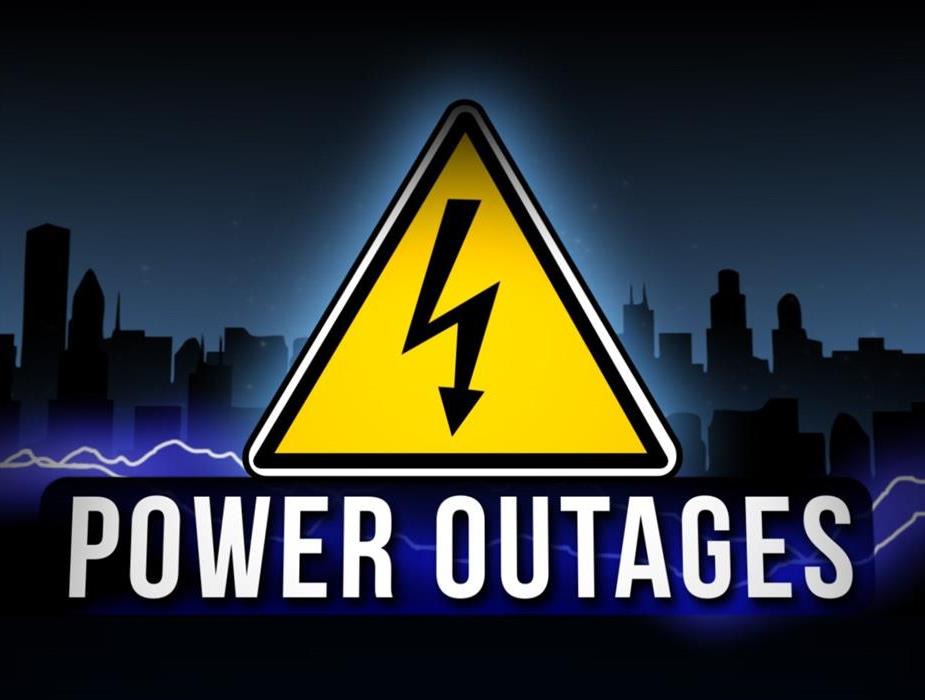 Storms often come with power outages.
Storms often come with power outages.
Power outages are not only an inconvenience; they can also end up causing costly damages. At SERVPRO of Joliet, we’ve seen first-hand the kind of property damage that can come as a result of a power outage. Even though it may seem counter-intuitive to think that a power outage itself can cause damage, the truth is that it can start a chain of events that becomes gradually more destructive.
To help protect yourself against the compounding damage that can come in the wake of a power outage, take these five steps.
#1: Exercise extreme caution when using candles, stoves, and generators.
It’s not uncommon to have a stash of long-burning candles tucked away for just such an emergency as a power outage. The use of candles isn’t itself necessarily dangerous; however, unattended, lit candles can quickly start a structure fire, potentially causing thousands in damage.
A good rule-of-thumb to keep in mind during a power outage is never to use a gas stove to stay warm. As tempting as it may be, gas stove emissions contain carbon monoxide, which can accumulate in the air and cause serious personal harm—even death.
When it comes to the use of gas-powered generators, always be sure that they’re operated in a well-ventilated area, ideally near a window or exhaust fan. For the same reason using a gas stove to keep warm is a bad idea, generator emissions can also be very harmful.
Also, never use a charcoal grill as a means of producing warmth indoors. The smoke from burning charcoal can be incredibly dangerous to inhale.
#2: Defend against food spoilage by using ice coolers to preserve existing food.
If the power is going to be out for an extended period of time, then you’re going to need a strategy for preserving your refrigerated food.
While a typical freezer can be expected to stay cool for about 48 hours, the rest of the fridge is going to succumb to higher temperatures by about the 4-hour mark. For this reason, it might make sense to fill a cooler full of ice and preserve whatever refrigerated foods you can.
Also, try not to open freezer or refrigerator doors more than is absolutely necessary, to conserve the cool.
#3: Deactivate and unplug appliances.
This especially applies to older appliances that may not have modern surge protection built into them.
When the power comes back on after a power outage, it’s possible that the sudden surge of electricity could cause damage to whatever is plugged in. After a power outage has taken place, walk through each room and check to ensure that appliances are in the ‘off’ position and/or unplugged from the wall.
[Tip: If you live in an area where power outages are especially common, it might be worth investing in a 12-volt battery and inverter combination. Most auto parts stores carry power inverters that can turn 12-volt DC power into 120-volt AC power for supplemental use by critical appliances.]
#4: Stay tuned in to local news outlets or radio transmissions for updates.
During a prolonged power outage, staying current on developments is critical to mitigating damage. Keep yourself apprised of the power outage status by opting into SMS text alerts from your local utility provider.
While it is possible for power outages to affect cellular transmission towers, this is very rare, which means you’re likely to still have a cell phone connection during an outage. Use your phone to stay abreast of what’s going on around you.
Identify the Causes Behind Your Flooded Basement
8/11/2020 (Permalink)
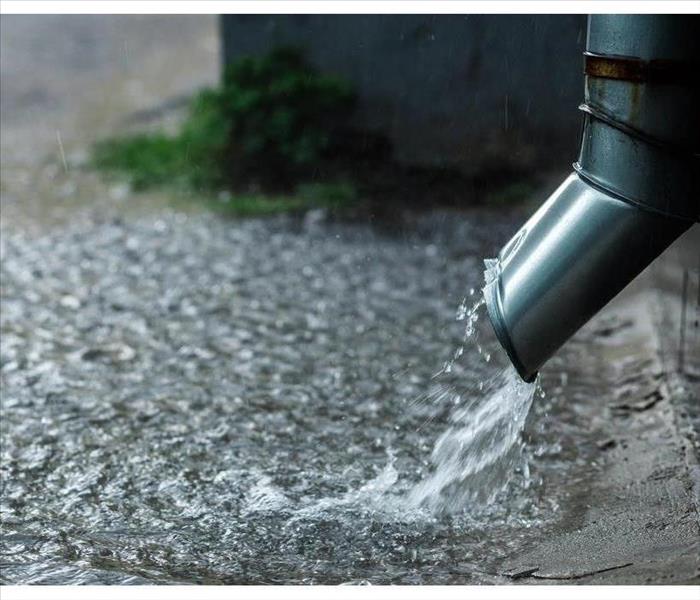 Make sure downspouts are extended to at least three feet away from your house to avoid flooding
Make sure downspouts are extended to at least three feet away from your house to avoid flooding
When water starts filling your basement, it can be hard to find the source of the problem. Without a proper solution, the flooding can cause major damage to your home and require water damage repair services. Knowing the various causes behind a flooded basement can help you prevent future incidents.
Common Causes of Flooding
The source of the problem can stem from several different places, including:
- Downspouts
- Gutters
- Slanted pavement
- Sloped landscapes
You can conduct your own home inspection to find the cause of the flooded basement. Regular gutter and downspout checks can prevent debris from accumulating and causing backups. It is also advised that you regularly inspect the perimeter of your home to determine whether the paving has settled in a way that is filtering water back into your home. Keeping a watchful eye over your property will curb future problems. Sewage Backups and
Flooding
Sometimes the problem is not visible on the surface. Sewer systems can also cause backing up, especially if your home has a combined system. This type of system handles both water run-off and sewage. During a heavy rainstorm, the system can become overwhelmed and send water pouring back into the home. Older homes have the additional issue of being connected to the system in your Joliet, IL. If run-off or sewage water floods the system, then you might experience severe back-ups. If the system is the cause of the flooding, then a professional repair service is the best source of assistance. Identifying the Cause of Water Build-up
There is no one cause of a flooded basement. Though it can be difficult to identify the source of the problem, you can be proactive by regularly inspecting your home for potential problems. If your home has recently been flooded, then you are advised to seek out a professional service to repair the damage. This is the best way to restore your home to its former state.
A Fierce Winter Storm Can Shred a Roof and Ruin Your Home
4/29/2020 (Permalink)
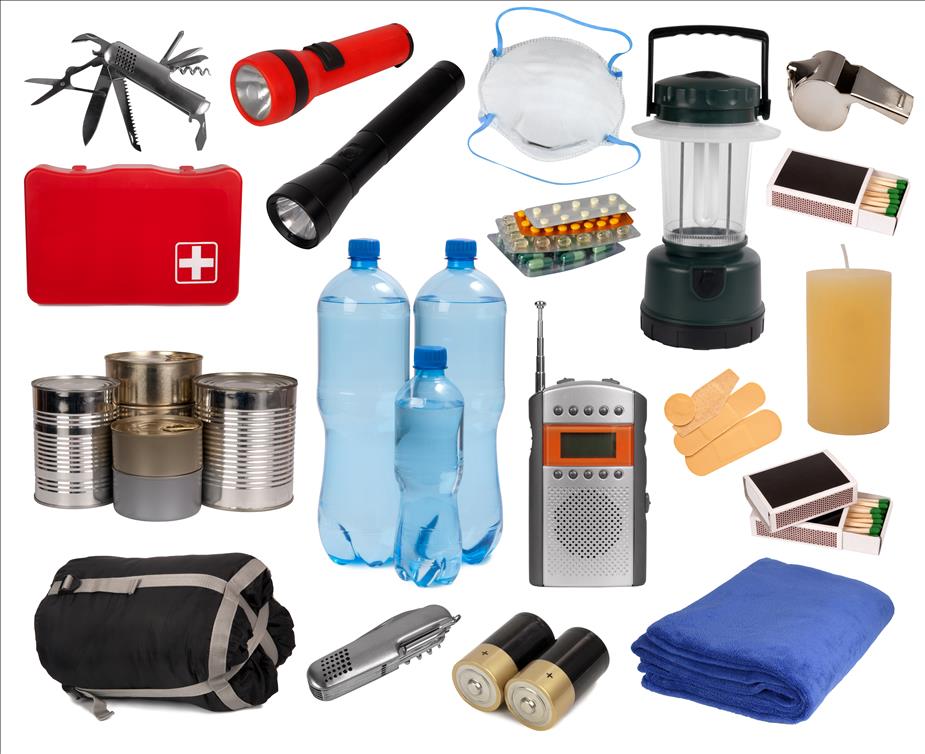 Disaster preparedness supplies
Disaster preparedness supplies
Residents in Joliet, IL, are no strangers to a winter storm. Most will pass with little or no damage, but a severe blizzard can leave an entire region reeling from the impact. Just one example, the 1993 “Storm of the Century,” impacted 40% of the population in the United States, caused 10 million homes to lose power, and killed 208 people.
Be Prepared
With some simple steps, you can be ready for even the nastiest winter storm. The National Weather Service recommends that all homes that may expect winter weather should have
- Extra batteries for flashlights
- A portable weather radio (consider also having a hand-cranked one)
- Emergency no-cook rations and clean water
- Extra pet food
- Diapers and baby formula
- Emergency heat
Be Extra Careful With Emergency Heat and Generators
There are many options for providing heat in an emergency. However, it’s very easy to cause accidental fires with portable heaters and candles. Even more insidious, ventless heaters and generators create carbon monoxide, a deadly, odorless gas that kills over 400 people per year. Read the instructions very carefully and always have a carbon monoxide detector installed when using them. Also, never, ever use a portable generator inside.
Heavy Snow Drops Trees and Caves in Roofs
When snow is wet, it clings to trees like sticky syrup. Ice storms also cause build-up on trees. In both cases, it’s normal for a few homes to suffer major roof damage from falling trees and limbs in a major winter storm.
Snow and ice also build up on roofs. Most modern homes in Joliet, IL, are designed to withstand normal snowfalls, but for roofs without steep pitches, it’s still recommended to remove excess snow to reduce the stress. A roof rake is the simplest way to do this, but you should never attempt to use one while on a ladder or climb onto the roof itself.
If your roof has been damaged, you’ll need a local storm damage restoration company to tarp over the exposed areas as soon as possible. They can then begin the repair process and fix internal water damage as well.
Prepare Your Building's Exterior for Storm Season
4/7/2020 (Permalink)
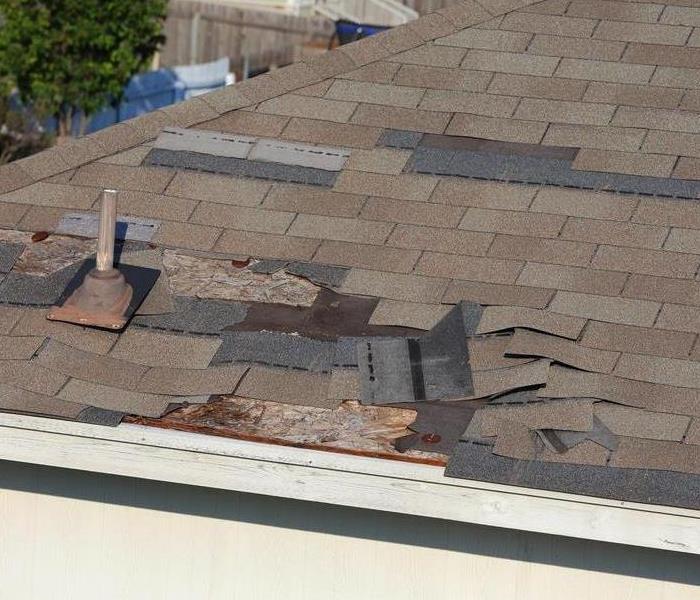 Creating an exterior maintenance plan will not only keep your building maintained during storm season.
Creating an exterior maintenance plan will not only keep your building maintained during storm season.
It is important to keep your building’s exterior well maintained all year long. A small spot of rust or a tiny crack may appear to be no big deal, but if it isn’t repaired quickly it can turn into a huge problem. During storm season, the risks of damage become that much greater. Setting up a routine exterior maintenance inspection for your building in Joliet, IL is a wise idea.
Develop an Exterior Building Checklist
Designing a checklist for your building inspection will reduce the risk of overlooking an important area. Checklists can vary, depending on the type of building you own, but typical exterior maintenance will include the following items.
Roof inspection - Check for such things as:
Debris clogging the drainage system or evidence of pooling water
Structural damage, including cracks or punctures
Buckled or missing shingles
Discolored or stained surfaces
Exterior walls - Look for cracks, staining, rust, peeling and any structural damage.
Exterior windows - Inspect for broken panes, cracks and leaks.
Gutters - Make sure they are free of debris and have no visible cracks.
Outside lighting - Check to ensure all lights are working and in good repair.
Paved surfaces - Look for raised areas and cracks. Also, remove any trash or debris from the yard.
Create an Automatic Maintenance Work Order
After you have completed the checklist, have your maintenance staff review it to make sure it’s comprehensive. If you have an automated work order system, create an ongoing work order reminder for designated intervals. Depending on the structure of your building and the climate you live in, the inspections could be conducted monthly, semiannually or annually.
Designate the person responsible for conducting the inspections. You can rotate the responsibility to different employees and include the assignments on the checklist.
Creating an exterior maintenance plan will not only keep your building maintained during storm season, but it will also reduce the risk of costly repairs all year long.
3 Things To Know About Black Water
4/3/2020 (Permalink)
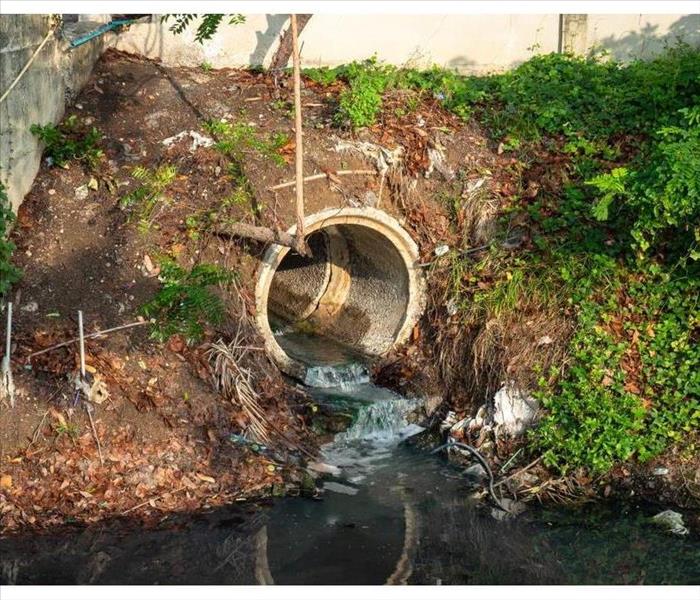 Sewage water counts in the black category
Sewage water counts in the black category
3 Things To Know About Black Water
When you expect a storm in Crest Hill, IL, protecting your company from water damage can be important. But did you know that flood water is classified as black water and can require some extra cleanup steps if your property experiences flooding? Fortunately, a local restoration team can help.
1. Water Is Categorized
It’s important to know that water is often broken into three categories. This is done to help restoration teams know what steps to use when cleaning up after a flood. White water is considered safe for human consumption and is mostly clean, often resulting from a broken faucet or pipe. Greywater is used water that may contain food particles or mild cleaners. Blackwater is any water that may have come in contact with fecal matter.
2. What Counts as Black Water
Any water that have potentially come in contact with sewage material, such as sewage, field runoff, or storm flooding can count in the black category. If this type causes water damage in your place of business it’s best to contact a professional for help as special cleaning and sanitation steps may be required.
3. Who Should Perform the Restoration
If you have damage from flooding it’s highly recommended to contact a local storm damage restoration service to conduct cleaning and repairs as quickly as possible. These professionals are trained in a number of restoration techniques, meaning than not only can they handle flooding, but mold mitigation as well. They will also be able to thoroughly clean and sanitize the affected area to prevent the spread of any bacteria that may have been present in the water.
Understanding what category flood water damage falls into can help you take the necessary steps during cleanup. Contacting a restoration crew is recommended as they have the proper tools to both clean and sanitize the area, making it once again safe for daily operations. If you have any questions, your restoration service can help.
Preparedness for Pets
3/9/2020 (Permalink)
 Include your pet in your evacuation plans and don't leave them behind where they can be lost or injured.
Include your pet in your evacuation plans and don't leave them behind where they can be lost or injured.
After Hurricane Katrina it was estimated that over 15,500 animals were ultimately rescued. Of the 15,500, only 15-20% were reunited with their owners.
Pets are just as important as any family member to most people so make them part of your preparedness planning. Several things that you can do to make sure they stay safe during an emergency are:
Build a Pet Emergency Kit
- Food - At least a three day supply in an airtight, waterproof container.
- Water - At least a three day supply.
- Medicines and medical records
- Important documents - such as registration, adoption and vaccination papers.
- First Aid Kit
- Collar or harness with ID tag, rabies, tag and leash
- Crate or pet carrier - Have a sturdy, safe crate or carrier in case you need to evacuate. There should be enough space for the pet to stand, lie down or turn around in.
- Sanitation - Pet litter and litter box, newspapers, paper towels, plastic trash bags, and antibacterial wipes.
- Picture of you and your pet together - If you become separated, the photo will help as documentation of ownership and help others to assist you.
- Familiar items - Not only is this a traumatic time for, but also for your pet. By having some items such as treats, toys and bedding make help alleviate stress on your pet.
Most important of all is to include your pet in your evacuation plans and don't leave them behind where they can be lost or injured. It is very important to have your pet micro chipped. In the event that you do get separated from your pet, it will be much easier for the animal to be traced back to it's owner.
For more information visit ready.gov/animals and remember that SERVPRO of Joliet 815-436-5735 knows that not only are your personal items important to you but so are your family pets. Keep them safe and be prepared!
How Technology Impacts Water Damage Restoration
10/16/2019 (Permalink)
Like everything in life, things change and processes get redeveloped to make things quicker, more efficient and with the end result in mind. This blog is going to talk about the various technologies that are used in water damage cleanup.
One such technology that is relatively new to the restoration industry is the use of drones to determine where water damage resides. Drones can find water damage in areas where it is deemed unsafe to roam into. With this access, the drone can also take pictures from angles that are not possible by a crew member and helps the insurance company to value out and determine what areas can be removed and what areas can be dried and or salvaged.
Another technological innovation within restoration is thermal imaging. This along with moisture readings can help to ensure that the structure can maintain a strong integrity after a water loss and keep the materials in line with the environmental conditions surrounding the material.
In the event of water damage in the Joliet, Crest Hill, Romeoville area, you can call your local SERVPRO experts at (815) 436-5735.
Storm Power Outages
8/30/2019 (Permalink)
Extended power outages may impact the whole community and the economy. A power outage is when the electrical power goes out unexpectedly. A power outage may:
Disrupt communications, water, and transportation.
Close retail businesses, grocery stores, gas stations, ATMs, banks, and other services.
Cause food spoilage and water contamination.
Prevent use of medical devices.
PROTECT YOURSELF DURING A POWER OUTAGE:
Keep freezers and refrigerators closed.
Only use generators outdoors and away from windows.
Do not use a gas stove to heat your home.
Disconnect appliances and electronics to avoid damage from electrical surges.
Have alternate plans for refrigerating medicines or using power-dependent medical devices.
If safe, go to an alternate location for heat or cooling.
Check on neighbors.
HOW TO STAY SAFE WHEN A POWER OUTAGE THREATENS:
Prepare NOW
- Take an inventory of the items you need that rely on electricity.
- Talk to your medical provider about a power outage plan for medical devices powered by electricity and refrigerated medicines. Find out how long medication can be stored at higher temperatures and get specific guidance for any medications that are critical for life.
- Plan for batteries and other alternatives to meet your needs when the power goes out.
- Sign up for local alerts and warning systems. Monitor weather reports.
- Install carbon monoxide detectors with battery backup in central locations on every level of your home.
- Determine whether your home phone will work in a power outage and how long battery backup will last.
- Review the supplies that are available in case of a power outage. Have flashlights with extra batteries for every household member. Have enough nonperishable food and water.
- Use a thermometer in the refrigerator and freezer so that you can know the temperature when the power is restored. Throw out food if the temperature is 40 degrees or higher.
- Keep mobile phones and other electric equipment charged and gas tanks full.
Sump Pumps
7/15/2019 (Permalink)
If you have a sump pump, most the time you don't realize how important it is until it stops working. Power outages, failure and a sump pump that cannot handle the capacity are common problems. Another is knowing how old is your sump pump?? Avoid potential problems by doing routine inspections or replacing your old sump pump. Usually sump pumps should be replaced every 5 years or according to manufacturers guidelines and each year the sump, switch and float should be inspected as well. Pay attention to how often the sump pump is running and if it runs regularly or there is a higher water table, consider a sump pump with higher horsepower.
Another way to increase the pump's efficiency and prolong life is to clean your sump pit, remove any dirt, sand, gravel and other debris routinely. Ensure that the discharge line opening is free of obstructions so that water can be pumped through the line and out of your basement or crawlspace and also be aware in the winter the discharge line may freeze bringing the water back into your house. Regular checks can make sure you don't ever get surprised by your sump pump!
SERVPRO of Joliet - (815) 436-5735
Wireless Emergency Alerts
6/3/2019 (Permalink)
Wireless Emergency Alerts
Wireless Emergency Alerts (WEA) are emergency messages sent by authorized government-alerting authorities through your mobile carrier. Government partners include local and state public agencies, FEMA, the FCC, the Department of Homeland Security, and the National Weather Service.
Alerts received at the right time can help keep you safe during an emergency. With WEA, alerts can be sent to your mobile device when you may be in harm's way, without need to download an app or subscribe to a service. WEA may be used to share;
- Extreme weather warnings
- Local emergencies requiring evacuation or immediate action
- AMBER alerts
- Presidential Alerts during a national emergency
A WEA will look like a text message, and typically show the type and time of the alert, any action you should take, and the agency issuing the alert. The message will be no more than 90 characters.
Visit www.ctia.org/wea to learn more about Wireless Emergency Alerts, including how to determine if your mobile device is WEA-capable.
Hire Professionals Who Understand
4/16/2019 (Permalink)
Whenever you have a problem with your home, the first impulse is usually to tackle the problem yourself. Sometimes this can be the right choice, and the problem’s easy enough to solve on your own. Other times it’s much safer and smarter to call in the pros from the beginning.
Tracking down tricky leaks is one of those times. Sure, some leaks are easy to track down, but water has a way of traveling odd paths. So once finding a leak gets tough, then it’s time to call in some help. And here’s why:
They Know Where to Look
Water can travel strange paths before it finally comes out into your home, and you might be surprised how far it can come. That discolored spot on your basement ceiling could actually be caused by a leak in your roof, or your wall on the opposite side of the house.
Professionals have tracked down hundreds, even thousands of leaks over the years. That experience gives them a wide variety of usual suspects to check, and a good number of unusual ones, too.
They Know What to Look For
That slight, turquoise line along your copper pipe? That’s where water has run along the outside and caused the copper to oxidize. It’s a sure sign that a leak is sending water traveling on the wrong side of the pipes.
Pros know these and dozens of other signs. What looks like a bit of dirt to you might indicate a serious leak in your roof, foundation, or wall. Or it might just be some dirt. A professional will be able to know the difference for certain.
They’ve Got the Right Equipment
Most of us can only use our eyes or sense of touch to lead us to water, but not the professionals. They have a wide variety of specialized equipment that can sense moisture and humidity through walls or probe underground for water deposits using ground penetrating radar.
This equipment can be expensive to buy and tricky to use. They have years of experience using the equipment, and know how to put it to good use.
SERVPRO of Joliet (815) 436-5735
Stratagies to Avoid Flooding
3/5/2019 (Permalink)
It is also important to keep your building’s drains clear. Clean leaves and dirt out of gutters at least once every other month. Make sure that ditches around your property don’t become trash receptacles. Keep It Green Your landscaping can help with flood prevention. Adding plants around your building can slow the flow of floodwaters. Flower beds can be built with water reservoirs under them, giving excess rain a place to go, if necessary. Trees and other plants with extensive root systems can combat erosion, preventing mudslides and the subsequent damage to your foundation. Keep It Routine Flood cleaning experts recommend that you adhere to a consistent inspection schedule. Building codes are in place to protect both the city and the building owner from preventable damage. By noticing problems and repairing them quickly, you can protect both your building and the infrastructure that supports it. Flood prevention works best when every entity at every level works together. If you do everything you can do to protect your building and the property on which it is built, you can help the city with its emergency flood plan as well.
Faster to Any Size Disaster
12/18/2018 (Permalink)
Being an industry leader with more than 1,400 franchises strong in cleanup and restoration, SERVPRO is equipped to handle any cleanup or restoration job no matter how large or small. With SERVPRO's Storm Response Team, SERVPRO of Joliet has access to vast resources at its disposal to help with any situation.
When a natural disaster sweeps through a region, whether it's a wildfire, blizzard, flood, tornado or hurricane; SERVPRO of Joliet Franchise Professionals knows your family can't afford to wait for your home to be restored to preloss condition. Every hour of unmitigated damage can cause more damage to your home or business and more stress and trauma to you or your family.
When disaster strikes, you need help, and you need it now. If the unthinkable happens and a natural disaster strikes your area, you can be sure SERVPRO of Joliet will be there, working to make it "Like it never even happened. Call 815-436-5735.
Tips to Prepare Your Home for Winter Ice Storms
11/14/2018 (Permalink)
Winter is once again coming and along with it comes one of your home's worst enemies; ice dams. Ice dams are continuous chunks of ice that form along the edges of your roof. During the warmer parts of a winter day, water melting off the roof pools behind the ice and then seeps back up under the shingles; causing damage to the interior of your home. To try and prevent ice dams, you have a few options:
- Make sure all gutters and downspouts are cleared of trapped leaves and debris.
- Being very careful, try to remove the snow off your roof after a heavy snowfall with a snow rake or call in a professional who can provide that type of service. Usually this can only be done on a single story home.
- Make sure that your attic is properly insulated and vented. Building codes require 12' to 14" of insulation.
- The next time you re-roof, run a special adhesive ice-and-water barrier 3" to 6" up the roof from the edge. It can be rather expensive but can save you money in the long run.
- Have heat cables installed on the edge of your roof where ice usually dams up.
As hard as we try to control some of the things that mother nature throws at us, it doesn't always work out. If you suspect you may have damage to your home due to ice damming or any other cause, give SERVPRO of Joliet a call at 815-436-5735 and we will send our trained professionals to help you with your problem.
The Do's and Dont's of Surviving a Flood
9/12/2018 (Permalink)
Flooding can happen at anytime and anywhere as a result of rain, snow coastal storms, storm surges and the overflow of dams and water systems. Just 6 inches of moving water can knock a person down and 1 foot of moving water is enough to sweep your vehicle away. Remember the following:
- Depending on where you are and the impact and warning time of the flooding, go to a previously identified safe location.
- If you are told to evacuate, leave immediately. Never drive around barricades that local responders have used to safely direct traffic out of flooded areas.
- Listen to EAS, NOAA Weather Radio or local alerting systems for current emergency information and instructions.
- Do not walk, swim, or drive through flood waters. Turn around.
- Stay off bridges over fast moving water. Bridges can be wash away without warning.
- If your vehicle is trapped in fast moving water, stay inside unless the water is rising inside the vehicle, then seek safety on the roof.
- If trapped in a building, go to the highest level. Do not go into a closed attic where you may be trapped by rising floodwater. Go to the roof if necessary and signal for help.
- Always remember to listen to authorities for information and instructions during a flood situation and return home only when they say it is safe to do so.
If a flood does strike your home or business, contact SERVPRO of Joliet at 815-436-5735 for all your water restoration needs.
Build an Emergency Kit
4/26/2018 (Permalink)
Be Prepared at your home or business with an Emergency Kit. Ready.gov suggests you have enough supplies to last for at least three days. Below are some suggested items to include in your kit:
- 3-day supply of non-perishable foods
- Water (one + gallon per person per day)
- Prescription medication
- Sleeping bag or blankets
- Fire extinguisher
- Hygiene products
- Flashlights
- Extra batteries
- Cell phone charger
- Change of clothes
- Matches in waterproof container
- Wrench or pliers to turn off utilities
- Whistle to signal for help
- Pet supplies
- Infant formula and diapers
- Important documents such as insurance policies, ID's, and bank records in a container
You can also keep a condensed emergency kit in your vehicle as well. For a more extensive list, check out Ready.gov. and remember, if needed; we are her to help you, call SERVPRO of Joliet at 815-436-5735.
April Showers Bring May Flowers
4/25/2018 (Permalink)
Hopefully April Showers will bring you May Flowers. May is a very busy month as school is coming to an end and summer is just around the corner.
The same is true for preparedness planning in May. The following preparedness events take place this month and offer a great chance to educate yourself, family, and friends.
- Wildfire Community Preparedness Day (May 5, 2018)
- National Hurricane Preparedness Week (May 6-12, 2018)
- National Dam Safety Awareness Day (May 31, 2018)
- National Building Safety Month
May also brings to weeks to show appreciation for first responders:
- National Police Week (May 13-19, 2018)
- National Emergency Medical Services (EMS) Week (May 20-26, 2018)
Be sure to visit ready.gov for more information and resources and remember SERVPRO of Joliet, 815-436-5735 is ready in any disaster to make it "Like it never even happened."
When storms or floods hit Joliet, SERVPRO is ready!
4/10/2018 (Permalink)
SERVPRO of Joliet specializes in storm and flood damage restoration. Our crews are highly trained and we use specialized equipment to restore your property to its pre-storm condition.
Faster Response
Since we are locally owned and operated, we are able to respond quicker with the right resources, which is extremely important. A faster response lessens the damage, limits further damage, and reduces the restoration cost.
Resources to Handle Floods and Storms
When storms hit the Joliet area we can scale our resources to handle a large storm or flooding disaster. We can access equipment and personnel from a network of 1,650 franchises across the country and elite Disaster Recovery Teams that are strategically located throughout the United States.
If you have a storm or flood damage call SERVPRO of Joliet at 815-436-5735 and we will make it "Like it never even happened."
Make Sure Your Joliet Home is Storm Ready
4/10/2018 (Permalink)
Storms in the springtime are something we need to be ready for. We watch the news, but bad weather is still unpredictable, so we need to take steps to keep our homes safe from storm damage.
It is a really good idea to conduct an inspection of your home and grounds before inclement weather hits. A leaky roof or window can cause big problems during heavy rainfall and strong winds. Do all of your exterior doors and windows fit correctly? When was the last time you took a good look at your roof? These are all great questions to keep in mind.
Loose shutters and unstable large trees and bushes can present a real problem in high winds. Its a good idea to trim back trees and bushes with large, heavy branches that are not in good condition so that windows and vehicles are not in danger of storm damage in windy conditions.
Many homes in older cities have drainage ditches or creeks on the property. Take time to inspect these areas and remove debris or dirt that might obstruct the flow of water from a heavy rain. A clogged drainage ditch or creek bed can cause a lot of damage by flooding your property during, or even after, a storm.
In the event of a storm, do you have a system in place that will help you get information to everyone you care about in case of a weather emergency? Most of us use our cell phones to communicate these days, but in the case of a bad storm, your cell phone service could be at risk. You might consider a good old-fashion landline, just in case. If you or a family member gets stuck at work or out doing errands, others will worry, so keeping those lines of communication open can keep everyone safe and worry-free.
The SERVPRO team at Joliet is here to help in the event of storm damage, fire damage, or mold issues. Call SERVPRO of Joliet and we will make it "Like it never even happened."
Severe Weather Safety
3/16/2018 (Permalink)
Severe weather can happen any time, anywhere. Each year, Americans cope with an average of the following intense storms (noaa.gov):
10,000 severe thunderstorms
5,000 floods or flash floods
1,300 tornadoes
2 landfalling deadly hurricanes
Approximately 98 percent of all presidentially declared disasters are weather related, leading to around 650 deaths per year and nearly $15 billion in damage. Knowing your risk of severe weather, taking action, and being an example are just a few steps you can take to be better prepared to save your life and assist in saving the lives of others.
Know your risk. The first step to becoming weather-ready is to understand the type of hazardous weather that can affect where you live and work, and how the weather could impact you, your business and your family. Check the weather forecast regularly, obtain NOAA Weather Radio, and learn about Wireless Emergency Alerts. Severe weather comes in many forms, and your shelter plan should include all types of local hazards.
Take Action. Take the next step in severe weather preparedness by creating a communications plan for your home and business. Put together or purchase an emergency kit. Keep important papers and valuables in a safe place.
Be an Example. Once you have taken action to prepare for severe weather, share your story with co-workers and family and friends on Facebook or Twitter. Your preparedness story will inspire others to do the same.
SERVPRO of Joliet can help you be "Ready for whatever happens!"
Dangers of Extreme Cold
1/24/2018 (Permalink)
According to the National Weather Service, $2.84 million dollars of property damage was caused by extreme cold in 2015.
Even scarier? Fifty-three people died and three were injured due to extreme cold the same year.
It is important to be aware of the effect temperatures can have on you. The two mailconditions to be aware of are frostbite and hypothermia.
Frostbite is caused when your skin is exposed to extremely cold temperatures. Physical symptoms are white or grayish-yellow skin,skin that feels unusually firm, or waxy numbness.
Hypothermia is when your body temperature falls to an abnormally low temperature, caused from long exposure to cold weather. Signs of hypothermia include shivering, exhaustion, confusion, fumbling hands, memory loss,slurred speech, and drowsiness. If someone’s body temperature is below 95 degrees Fahrenheit seek medical attention immediately.
To avaid these conditions, stay indoors if possible. If not, dress warm in layers and try to keep dry.
Winter Weather
12/21/2017 (Permalink)
As the weather outside gets frightful and your cozy homes become warm and delightful, the holiday season’s aglow, let it snow, let it snow, let it snow. According to climate.gov, on February 12, 2010, there was snow present in all 50 states, including Hawaii! Five years later in 2015, it almost happened again, when every state but Florida experienced snow. While it is generally unlikely for certain states to encounter snow, it is still important to know how to be prepared if winter weather strikes your home, business, or while traveling.
What happens if disaster does strike during the most wonderful time of the year? Easy - Call SERVPRO of Joliet, even if it’s the night before Christmas and we will make it “Like it never even happened.”
Severe Weather Preparedness
6/12/2017 (Permalink)
Severe weather can happen any time, anywhere. Being prepared to act quickly can be critical to staying safe during a weather event. Knowing your risk of severe weather, taking action and being an example are just a few steps you can take to be better prepared to save your life and assist in saving the lives of others.
The first step to becoming weather-ready is to understand the type of hazardous weather that can affect where you live and work, and how the weather could impact you and your family. Check the weather forecast regularly, obtain a NOAA Weather Radio, and learn about Wireless Emergency Alerts. Severe weather comes in many forms and your shelter plan should include all types of local hazards.
Take the next step in severe weather preparedness by creating a communications plan for your family. Put together or purchase an emergency kit. Keep important papers and valuables in a safe place.
Once you have taken action to prepare for severe weather, share your story with family and friends on Facebook or Twitter. Your preparedness story will inspire others do the same.
Severe Weather Safety-General
4/10/2017 (Permalink)
Hundreds of people die each year in the United States due to heat waves, hurricanes, lightning, flash floods, powerful thunderstorm winds, and winter storms or winter cold. Additionally, thousands of people are injured by these weather events each year. If you are aware of what weather event is about to impact your area, you are more likely to survive such an event. To stay on top of the weather, utilize NOAA Weather Radio All Hazards receiver units that can be purchased at most electronic stores. Make sure the model you purchase has a battery-backup. You should also obtain the latest weather information from commercial TV/radio, cable TV, the internet/web, and newspapers. It’s your responsibility!
What else can you do to prepare for severe weather?
- Develop a disaster plan for you and your family at home, work, school, and when outdoors. The American Red Cross offers planning tips and information on a putting together a disaster supplies kit at www.redcross.org.
- Identify a safe place to take shelter.
- Know the county in which you live or visit – and in what part of that county you are located. The National Weather Service issues severe weather warnings on a county basis.
- Check the weather forecast before leaving for extended periods outdoors. Watch for signs of approaching storms.
- If severe weather threatens, check on people who are elderly, very young, or physically or mentally disabled. Don’t forget about pets and farm animals.
Severe Weather Safety - Straight Line Winds/Large Hail
4/10/2017 (Permalink)
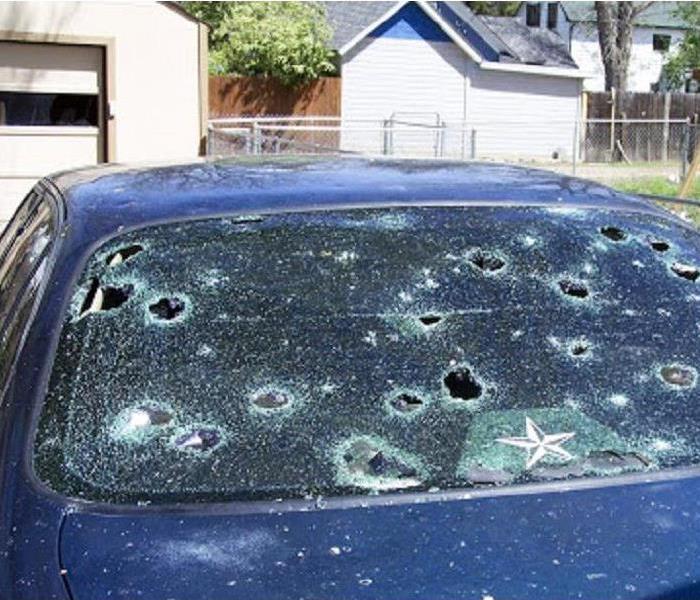 Car damaged by hail
Car damaged by hail
Severe Thunderstorm Straight-line Winds:
- Don’t underestimate the power of strong thunderstorm winds known as straight-line winds – they can reach speeds of 100 to 150 mph. Hurricane-force winds start at 74 mph. Illinois does experience these kinds of winds!
- If a severe thunderstorm warning contains hurricane-force wind speeds seek shelter immediately (as you would for a tornado situation).Stay away from windows and go to the basement or interior room/hallway. Do not use electrical appliances.
- Be aware that tall trees near a building can be uprooted by straight-line winds – that tree can come crashing through the roof of a home and crush a person to death.
- Powerful straight-line winds can overturn a vehicle or even make a person air-borne when they get up over 100 mph!
- One type of a straight-line wind event is a downburst, which is a small area of rapidly descending rain-cooled air and rain beneath a thunderstorm. A downburst can cause damage equivalent to a strong tornado!
Large Hail:
- Although it is rare, people have been killed by large hail stones after sustaining head injuries. Additionally, several people are injured by large hail stones each year in the U.S.
- Some thunderstorms can produce large hail stones that can reach the size of baseballs, softballs, or even as big as computer compact discs (CD) or DVDs! These large hail stones can fall at speeds over 100 mph! – that’s why they are dangerous!
- If a severe storm is producing large hail stones, seek a sturdy shelter and stay away from windows that can easily be smashed.
- If you are in your vehicle before the hail storm starts, get out of it and go to a sturdy shelter. Glass windows in vehicles can easily be smashed by the hail stones. If you can’t get out of your vehicle, then come to a stop and cover your head with your arms and hands.
Thunderstorm Safety
5/26/2016 (Permalink)
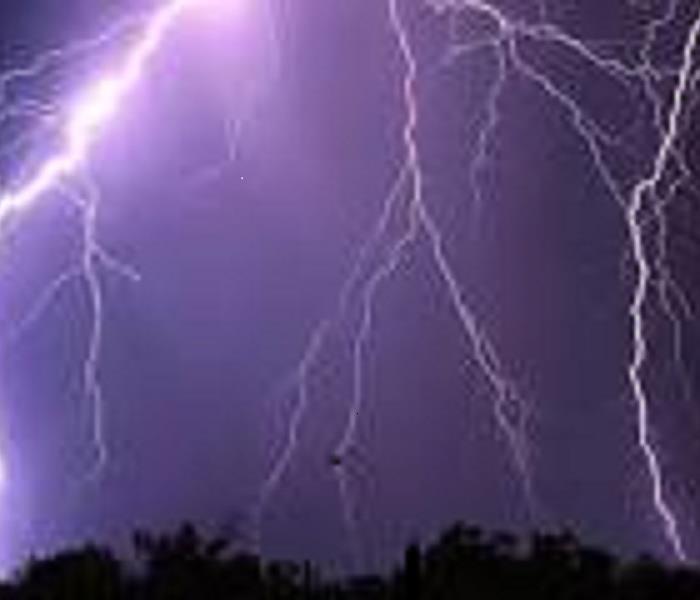 Lightening can lead to fires.
Lightening can lead to fires.
As we are nearing the end of spring and transitioning into summer, there is no better time to review thunderstorm safety. Remember enjoying a good, summer thunderstorm? Those days seem long ago as thunderstorms today seem to have the ability to turn severe quickly! Bottom line is that thunderstorms are dangerous. Every thunderstorm produces lightning. On average in the U.S., lightning kills 51 people and injures hundreds more. Other associated dangers of thunderstorms include tornadoes, strong winds, hail and flash flooding. Flash flooding is responsible for more fatalities than any other thunderstorm-associated hazard. To begin preparing for a thunderstorm, and any weather related disaster, you should build an emergency kit and make a family communications plan. Investing in a NOAA Weather Radio is also a good idea. During a thunderstorm always seek shelter. Avoid contact with electrical equipment, cords and plumbing. Plumbing and electrical appliances can conduct electricity. A Thunderstorm Warning is more serious than a Thunderstorm Watch. However, if a Watch or Warning is issued, take it seriously and find shelter! As the Memorial Day weekend approaches and thunderstorms are in the forecast, remember these tips. Enjoy and be safe! Happy Memorial Day!
Tornado Awareness
4/5/2016 (Permalink)
All kidding aside, April is Tornado Awareness month. Are you prepared? Check out www.ready.illinois.gov for some great preparedness tips. If you have a business and no emergency plan in place, contact us at (815)436-5735 to set up your no cost Emergency Ready Profile.
Ice Dams & Winter
1/14/2016 (Permalink)
An ice dam is a ridge of ice that forms at the edge of a roof and prevents melting snow (water) from draining off the roof. The water that backs up behind the dam can leak into a home and cause damage to walls, ceilings, insulation, and other areas.






 24/7 Emergency Service
24/7 Emergency Service
